Bryan Sebesta is a software and technology designer based in New York City. He frequently blogs on books on LDS topics at staggeronwardrejoicing.com.
Knowing that we’d all be reading the Book of Mormon together this year, I resolved to take Ben Spackman’s advice: you cannot fully learn from scripture unless you are also actively learning about scripture. A mix of whim and intent led me to learn from these four books. Three are directly about the Book of Mormon–one indirectly–but each rewarded me with new approaches for galvanizing my study of Mormon’s book.
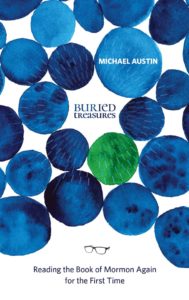 Michael Austin. Buried Treasures: Reading the Book of Mormon Again for the First Time. BCC Press, 2020
Michael Austin. Buried Treasures: Reading the Book of Mormon Again for the First Time. BCC Press, 2020
Buried Treasures is Michael Austin’s chronicle of him reading, for the first time after 30 years, the Book of Mormon. Having spent the better portion of that intervening span analyzing and teaching great literature as an academic, he admits he was afraid the Book of Mormon wouldn’t measure up to the great works he had spent so long studying and teaching. His report? “I was wrong… it is a book that Latter-day Saints should never be ashamed to place alongside the great books of the world’s traditions—both religious and secular.”
This chronicle is composed of 44 short chapters, written originally as blog posts, so they’re short and accessible; they range across the whole Book of Mormon. Some chapters read like sermons, drawing principles to live by from the text and with quotes I’d happily draw from when preparing a Sacrament talk. Other chapters show you some literary or rhetorical aspect of the Book of Mormon that makes you appreciate how rich the Book of Mormon really is. My favorites were “Alma and the Dunbar Number,” “Why Alma’s Mission Failed while Ammon’s Succeeded,” and “Why the ‘Anti-Nephi-Lehis’ Matter Today.” (That last one, especially, touched me deeply.)
But calling those favorites belies how much I loved the entire book. He has some great insights onto warfare in the Book of Mormon, including how nearly ever war was, in fact, a civil war. He walks you through the “typological” connections in the Book of Mormons, the allusions the Book makes to itself and the Bible, that enhance it richly. (The connections between Lehi’s Tree of Life Vision and the Fall story in the Bible was especially enlightening.) He dwells on how the Book would have been received by the faithful saints in the 1830s. And he shows you, too, how to read “against the grain” at parts: questioning some of Mormon’s decisions, especially when it comes to how Mormon depicts religious freedom and warfare. Far from diminishing my faith in the Book of Mormon, it enhanced it: for it showed that the Book is precisely what it claims to be, an inspired tragedy commissioned by God, but written in the limited perspective of a faithful but flawed historian, doing the best for his people and for the people he knew would inherit his book a millennium-and-a-half down the line, testifying of Christ.
I heartily recommend this collection. There were some observations I disagreed with, and several small grammatical mistakes, but the substance and range of the insights have expanded my view of the Book of Mormon immensely. It’s accessible and handy and always thought-provoking, and as I read the Book of Mormon each year, I’m going to be looking back to this book to see what buried treasures I might have missed.
[UPDATE: Michael Austin added “an additional chapter” through a blogpost here, called “Enos and the Joy of the Saints.” It’s an excellent addition.]
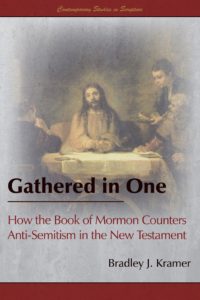 Bradley J. Kramer. Gathered in One: How the Book of Mormon Counters Anti-Semitism in the New Testament. Greg Kofford Books, 2019
Bradley J. Kramer. Gathered in One: How the Book of Mormon Counters Anti-Semitism in the New Testament. Greg Kofford Books, 2019
This is a profound book. It’s reframed how I see my role in God’s plan–not the “Plan of Salvation” per se, at least not as most Latter-day Saints understand it–but God’s historical plan of redemption, his actions with Jews and Gentiles. In other words, salvific history. By drawing out new meaning (which was always there) from the Book of Mormon, about what it says regarding Jews and Gentiles and the relationship between.
There is, in other words, more to the “rise” of the Gentiles than the New Testament records. According to the Book of Mormon, there is another chapter to this story, perhaps even several chapters. After the Jews have helped the Gentiles—sending them Peter, Paul, and other missionaries of Jewish descent to teach them—and after the Gentiles have prospered spiritually and materially as a result of these teachings, they will then help the Jews—gathering them in, supporting them, respecting them, building them up, helping them fulfill their mission in their own land and on their own terms. Like the Anti-Nephi-Lehites and the Nephites, the Gentiles and the Jews will not be in conflict or in competition. Many Gentiles will be folded in with Jews and “numbered among the house of Israel” (1 Ne. 14:2).
This book helped me answer some long-standing questions I’ve had about the relationship between Latter-day Saints, Christians, and Jews. And while I still have many, many questions left unanswered, this gave me a solid starting point for better understanding the Book of Mormon, the New Testament, and God’s plan for his people.
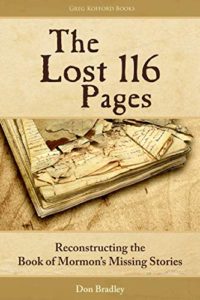 Don Bradley. The Lost 116 Pages: Reconstructing the Book of Mormon’s Missing Stories. Greg Kofford Books, 2019
Don Bradley. The Lost 116 Pages: Reconstructing the Book of Mormon’s Missing Stories. Greg Kofford Books, 2019
Don Bradley has done the world, both LDS and non-believer, a tremendous service with this book, which accomplishes two incredible things: first, he’s brought together all of the available data on the nature of the “lost 116 pages” that constituted the original beginning to the Book of Mormon; second, he’s offered a wonderful interpretation of that data, piecing together a story of a remarkable beginning to Mormon’s book.
The first half, constituting five chapters, chronicle the story of the lost pages, telling a familiar story in a novel way: Joseph’s experience getting the plates, translating the “sealed book,” and using the interpreters and seer stones; and then the tragic story of the pages lost, rendered all the more tragic (to me) by personal details of Martin Harris’ life and the fact that the “lost 116 pages” was probably closer to 200 or even 300 pages, constituting in length at least a third (and maybe more) of the Book of Mormon we have today. He also dives more deeply into the identity of the thief, acting to exonerate Lucy Harris (the traditional thief) and identifying several other more prime suspects.
The second half, made up of ten chapters, works to reconstruct “the missing stories”–using both clues from our existing Book of Mormon, and quotes from those familiar with the contents of the lost pages. Some of the chapter titles give away the key ideas: “A passover setting for Lehi’s exodus,” “Lehi’s tabernacle in the wilderness,” “the seven tribes of Lehi,” “The Mosian reform,” “The Book of Benjamin,” etc. In each of them, detective work ensues. And I should say Don Bradley is the closest thing to a “Latter-day Saint detective” that I know: reading Bradley reconstruct these narratives felt like reading a Sherlock Holmes story–in the best way possible–piecing together small bits of data in ways I’d never have dreamed of, but felt “obvious” after the fact. A good example is in his chapter on “The Lost Middle Period,” where he draws from little details about how Mormon normally introduces geography, and how Mormon puts together timelines, to reconstruct the centuries between Jacob and Mosiah. He’s also very adept at noticing intertextual clues. A good example of this is in noting connections between the story of Nephi and Laban and the biblical story of David and Goliath, an insight that will forever change the way I read that oft-told tale that begins our published Book of Mormon.
What comes together in these pages is a vision of a “more biblical” Book of Mormon: one even more tied to the Bible than I thought. AndI was left with three distinct impressions: first, I was left convinced that Lehi and Nephi were more conscious of forming a “new Israel” than I’d ever imagined, with their own passover and exodus, tabernacle, conquest, and monarchy. Second, I left with a newfound appreciation for the “Mormon” behind Mormon’s book: the powerful verbal and typological “hyperlinks” in the book that link tales both to Israel’s scripture and other parts of Lehite history. And third, given that the lost manuscript was the first “revelation” received by Joseph Smith, I left with a better grasp of how this early revelation shaped Joseph Smith’s project, the restoration.
I’m not necessarily qualified to weigh in on all the data. Bradley would be the first to tell you that some of his insights are more certain than others, and that others will build on his work, adding more data and/or drawing new conclusions. But this cannot be disputed: the book is remarkable. And it helps to cap off a remarkable ten years in Book of Mormon studies, belonging alongside Grant Hardy’s Understanding the Book of Mormon and Study Edition of the Book of Mormon, Royal Skousen’s The Earliest Text, Joseph Spencer’s A Vision of All, Bradley J. Kramer’s Beholding the Tree of Life and Gathered in One, and Brant Gardner’s impressive Second Witness commentary. I can’t recommend this book enough.
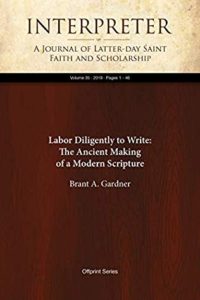 Brant A. Gardner. Labor Diligently to Write: The Ancient Making of a Modern Scripture. The Interpreter Foundation, 2019.
Brant A. Gardner. Labor Diligently to Write: The Ancient Making of a Modern Scripture. The Interpreter Foundation, 2019.
This important book, serialized in the Interpreter Journal in eight-to-nine parts, builds on Brant Gardner’s prolific portfolio of studies on the Book of Mormon by asking some very specific questions “about a very specific aspect of two different men.” Gardner poses his main question this way:
Nephi conceived writing Nephite history. Mormon conceived turning that history into a message to a future generation. Each wrote with purpose and elaborated that purpose by recounting stories. Knowing that each man used a chronology of events as the backbone structuring his intent, how did they select and then write the stories so Nephite history served their larger intent?
At first, I thought this might mean a “literary” approach, following what Grant Hardy has done. While there are literary aspects of this project, it resembles more a “source criticism” approach, trying to do for the Book of Mormon what source criticism has done for the Bible–identify the strands of thought and sources that make up each Biblical book. But of course, the comparison isn’t quite fair: unlike the authors and redactors of the Hebrew Bible, we know so much more about the Book of Mormon’s abridgment, because Nephi and Mormon both allude quite often to what they are doing. Both men leave explicit notes and implicit clues about how they built their book from their life experience and their life work. And both are very pointed about how they hope their work will be read.
The way Gardner approaches this is by dividing the book into two parts: first, he looks closely at the writers themselves. “What do we know about them? How did they learn to do what they did? What sources did they use, and what techniques did they employ to further their messages?” In the second part, he begins to interrogate the writers’ handiwork: “What drove the creation of specific chapters? What message was intended by the stories selected and the way they were told?”
Several things stuck out to me. Gardner is very attuned to detecting structure in the text: for every “and it came to pass,” “now,” and “behold,” he’s detected patterns that show how Nephi and Mormon use these terms in purposeful way. Additionally, I’ve always wondered about the original chapter breaks–which seem to have been designed by Nephi and Mormon. But they have never made sense. Gardner uncovers fascinating rules behind these, such as the “testificatory amen.” (Any “amen” exerts a nearly omniconsistent force in ending the old chapter and beginning a new one.) There are exceptions, and Gardner offers hypotheses for each.
He also notes–and I found this utterly fascinating–when Nephi and Mormon seem “triggered” by something. No, not in that way–what he means is that they’ll write something which will remind them of something else: something they promised to write earlier, or need to say now. So they’ll deviate into an aside or editorial, before returning to the planned episode or main narrative. There’s a detectable thrill in tracing the possible thought-lines of these two great authors, and trying to imagine them engraving each word and sentence.
There are so many other observations: repetetive resumption; sermons as chapter boundaries; the Mayan hotun, and its possible connection with Mormon’s calendrical system. There are new insights on every page. For me, the second half of the book–where Gardner walks through each original chapter division of the Book of Mormon–will be a constantly-consulted resource going forward. It is a fascinating, novel approach: I don’t think anyone has so systematically analyzed the subjective and objective experience of how Mormon and Nephi received their scribal training, drew from records and experience, made and engraved the plates, and set out to divide their records into chapters and episodes. It’s an incredible read. I can’t wait to revisit it.
(My one complaint: because the Interpreter Journal split this serialized book into five parts, and because Kindle titles are so long and almost exactly the same, and the specific chapters are at the very end of the title, I had SUCH a hard time finding the right book on my Kindle Paperwhite. Which was VERY frustrating. I look forward to seeing this as a single volume, though I’m not looking forward to having to re-annotate the entire thing–since my notes won’t transfer over. I’ll do it; it’s just annoying.)
(As a bonus, here is another review of a book about the scriptures)
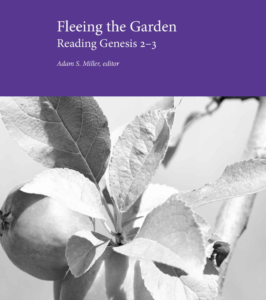 Adam S. Miller, editor. Fleeing the Garden: Reading Genesis 2-3.
Adam S. Miller, editor. Fleeing the Garden: Reading Genesis 2-3.
Neal A. Maxwell Institute, 2017
I really liked this book. It’s a set of seven essays (or eight, if you count Adam Miller’s introduction), each taking theological dives into Genesis 2-3. It was produced when, in either 2017 or 2016, six scholars–three women and three men–came together and spent months going over every verse, discussing it and all it could mean. They call this the Mormon Theological Seminar, and each essay has the scholar take their interests and training round again to the text of Genesis 2-3.
Now, with any anthology or compilation of essays, especially when they’re each by different people, there will be essays that resonate more strongly than others. Because I have only recently discovered the joys of exegesis, Ben Spackman, Jim Faulconer, and Julie Smith’s essays were particularly fascinating to me. Ben Spackman’s deep dive into the translation of “Adam” was revelatory for me; Faulconer’s essay helped me more vividly put myself in the place of ancient Jew, reading Genesis; and Julie Smith, in perhaps my favorite from the collection, helped me see how Eve’s “wise choice” theory, propounded by prophets from Joseph and Brigham to today, is both a wonderful and problematic reading, and offers other holistic frameworks for making sense of the ambiguities, though ultimately pointing out that no one explanation explains all of the text. All of these essays pay close attention to the text and invoke it often. Spackman and Smith’s essays also felt like different kinds of reception history. (Julie Smith’s footnotes tracing what different LDS leaders have interpreted the “wise choice” theory were, for me, worth the price of the book.)
(I also loved Adam Miller’s introduction about how God accommodates to our worldview when he reveals himself, though he makes the same points in more accessible language in his “Scripture” essay in Letters to a Young Mormon, which I was grateful I had read first.)
The other essays were also good readings, though it seemed to me that they were either drawing from the text of Genesis 2-3 less (using verses or scriptures as a springboard for theologizing) or drawing from the text in ways I doubt the original author of Genesis intended, or at least that weren’t the primary points of the text. Which isn’t to say they were bad, but they were different. The two essays on Genesis and the environment–Welch’s essay on Wendell Berry and localism, and Wendt’s essay on eco-literacy–touched me profoundly, since I’m living in a generation wrestling with the problem of poor planetary stewardship (aka climate change) and a deep disconnection with the land. These essays helped me see what Genesis might have to say about those modern-but-also-ancient problems.
Adam Miller’s main essay “on dirt, dung, and digestion in God’s garden” was extremely thought-provoking. I will never think about “bowels of mercy” the same way again, nor will I take for granted the messiness of embodiment. Importantly, he asks a question (twice in the chapter) that acts as a quiz, asking what we think the role of digestion will be in a resurrected state, that was arresting. (I still don’t know how I would answer it.) Joseph Spencer’s essay begins with a fascinating theology of the phrase “and it shall come to pass.” I was impressed by, and even enjoyed, how much he could draw from that simple phrase. But while I have found a lot of Spencer’s work profoundly accessible and interesting, I had a harder time connecting with this essay. Still, I trust there is something for me in there, and I intend to return later to re-read it again.

So again: I really enjoyed this book. A fun mix of theology, exegesis, reception history, and novel interpretation from one of the most challenging chapters in history.
